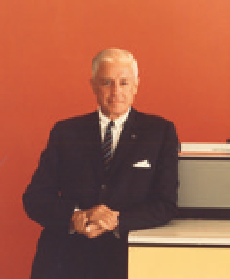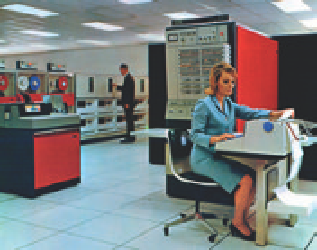Information Technology Reference
In-Depth Information
Microcode
In 1951, at a ceremony to inaugurate
the Manchester University computer,
Maurice Wilkes argued that “the best
way to design an automatic calculating
machine”
15
was to build its control sec-
tion as a stored-program computer of its
own. Each control operation, such as the
command to add two numbers, is broken
down into a series of
micro-operations
that
are stored in a
microprogram
. This method
had the advantage of allowing the hard-
ware design of the control unit to be sim-
plified while still allowing flexibility in
the choice of instruction set.
The microcode approach turned out
to be the key insight that enabled IBM to successfully implement its ambitious
“360” project (
Fig. 3.15
). The 360 project was an attempt by IBM in the mid-1960s
to make all IBM computers compatible with one another, simplifying what
many people saw as the confusing tangle of the company's machines. Thomas
Watson Jr. (
B.3.9
), then president of IBM, set up a group called the SPREAD
(Systems Programming, Research Engineering and Development) Committee
to investigate how this goal could be achieved. At one stage, two key architects of the System/360 family
of mainframe computers, Fred Brooks and Eugene Amdahl, argued that it couldn't be done. However, an
English engineer called John Fairclough (
B.3.10
), who was a member of SPREAD, had studied electrical engi-
neering at Manchester and learned about the advantages of Wilkes's microprogramming and microcode. It
was through him that IBM realized
that microcode offered a solution
to the problem of offering a com-
mon instruction set across the
System/360 family of computers.
Microcode also gave engineers
the possibility of offering
back-
ward compatibility
, which would
enable a new computer to run the
same software as previous ver-
sions of the machine. By install-
ing microcode that implemented
instructions written for programs
developed for earlier machines,
the older programs would still be
able to run on the new 360 com-
puter. Fairclough later became
director of IBM's UK Develop-
ment Laboratory at Hursley, near
Winchester (
Fig. 3.16
).
Fig. 3.15. The IBM System/360 was a
family of general-purpose mainframe
computers delivered in 1965. It was the
first line of computers designed to be
compatible with one another.
B.3.9. Thomas Watson Jr.
(1914-93), then president of IBM,
took an unprecedented gamble
by putting huge resources into
the IBM 360 project to unify
IBM's many different computing
systems. The gamble paid
off and changed the history
of computing. From 1979 to
1981, Watson served as the U.S.
ambassador in Moscow.
Fig. 3.16. IBM Hursley Laboratories near
Winchester, U.K. The Lab developed
several IBM computers and much
important software. The software
produced by Hursley includes one of
the best-selling software products of all-
time, CICS, for transaction processing -
the day-to-day transactions of banking,
airline ticket systems, and so on.
B.3.10. John Fairclough (1930-2003) played
an important role in the British computing
industry. He was a member of the IBM 360
team and, in 1974, he became managing
director of IBM Hursley Laboratory near
Winchester in England. In the 1980s,
Fairclough served as chief scientific adviser to
the British government. He strongly supported
close collaboration between universities and
computer designers and manufacturers.





Search WWH ::

Custom Search